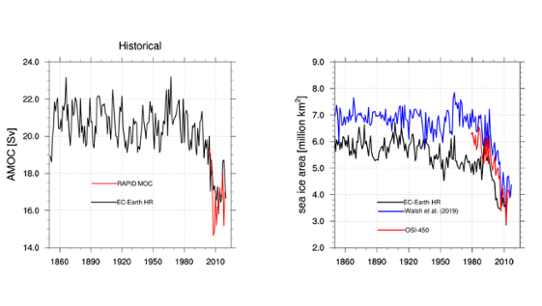The Gulf Stream is part of a large ocean current system called “Atlantic Meridional Overturning Circulation” (AMOC). The AMOC transports large amounts of heat poleward from the tropics, maintaining Europe’s mild climate for its latitude. New results indicate that the ongoing warming puts the AMOC at risk. An abrupt reduction of the AMOC would have dramatic effects on the climate in Europe. All climate models project an AMOC decline in the 21st century but the amplitude of the decline varies strongly across models, thus critically limiting the robustness of future climate projections for Europe. Insufficient resolution in the models to adequately represent the complex processes governing the AMOC, have been identified as main causes for the uncertainties.
Here, we will use a new high-resolution global climate model and perform cutting-edge future projections with unprecedented fidelity until year 2100 to investigate, how fast the AMOC will decline in the future, and thus provide more reliable future projections for Europe. We will also use high-resolution simulations of the Last Interglacial, which was the last period with a 2 ˚C warming and a 2˚C future as well as perform dedicated sensitivity studies to investigate the stability of the AMOC in a warmer world. Together with stakeholders from various societal sectors, we will analyse, discuss and interpret the results from our analysis and the consequences for the environment, society, economy and health.
Main objectives of the project
FutureGS aims to answer the questions, how fast will the AMOC and thus the Gulf Stream decline in the future, how large is the risk for a rapid reduction and what would be the impact for the European climate?
Specific goals are:
- Analyse the future change of the AMOC including the risk for a rapid reduction.
- Investigate how ocean convection in the various North Atlantic basins is forced and contribute to the strength of the AMOC.
- Investigate if the Last Interglacial could serve as an analogue for the development of the AMOC and its impacts in the future.
- Evaluate suggested fingerprints of AMOC change across a range of timescales and under different forcing scenarios in the Last Interglacial, the pre-industrial and in 2˚C future simulations.
- Provide more robust information on future climate change and its extremes in Europe and Sweden through a more reliable simulation of the AMOC in the high-resolution simulations.
- Provide this information to stakeholders from various societal sectors and discuss the potential consequences for their respective sector.
The work so far
Since the start of the project in January, we have done historical simulations and now the project is entering a new stage of analysis studies. The charts below show the AMOC/index of the Gulf Stream and Arctic sea ice in our historical simulation with the high-resolution EC-Earth version.

Project participants
- Swedish Meteorological and Hydrological Institute; Pl Torben Koenigk
- Swedish Meteorological and Hydrological Institute; Pasha Karami
- Stockholm University; PI Agatha de Boer
Timeline
FutureGS runs from January 2022 to December 2024.
Funding
FutureGS is funded by FORMAS.